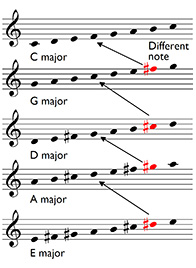5.4 Major scales having key signatures with sharps
Example 44 shows the major scales starting on C, G, D, A and E.
Example 44

Notice, firstly, that:
If we compare two scales that lie next to each other in the list, for instance, C major and G major, the only different note in the lower scale is the seventh note.
Both scales contain Cs, Ds, Es and so on, but in G major, we have F♯ (and not F as in C major) and this F♯ is the seventh note up the G major scale. Similarly, the note in D major that is different from those in G major is C♯, also the seventh note, and so on.
Secondly, notice that:
In each scale, the number of notes prefaced by sharps increases by one each time. C major has none, G major has one note prefaced by a sharp, D major two, A major three and E major four.
In order to avoid writing a sharp before every F in, say, a piece in G major (that is, a piece based on the scale of G major), a key signature, as shown in Example 45, is supplied at the beginning of each staff. At the opening of a piece, the key signature comes after the clef but before the time signature. The patterning of the sharps in the key signatures is logical, at least as far as four sharps. However, only the F♯ on the top line of the treble staff is shown, not the F♯ in the bottom space, and, similarly, only the C♯ in the third space from the bottom is written in, not the C♯ on the first ledger line below the staff. Although this is far from logical, it at least simplifies the visual information being presented.
Example 45

Before leaving this section, have another look at Example 44, and confirm how each scale is generated by the T T S T T T S pattern. Also, identify which notes need sharps in the different scales. Then consider the key signatures in Example 45 and how these relate to the scales in Example 44.
